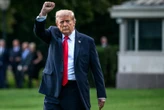In August, after getting an endorsement from Elon Musk, Donald Trump said that he supported a “very small slice” of cars being electric, saying that he had “no choice” because of Musk’s endorsement.
But that came after months of EV bashing. Last Christmas, Trump told EV supporters to “ROT IN HELL.” He has called Biden’s EV policies “lunacy.” He’s pledged to reverse Biden’s EV “mandate”—though there isn’t an actual mandate—on his first day as president. (In a meeting with oil industry executives in May, he reportedly said that he could get rid of Biden’s pro-EV policy if they donated $1 billion to his campaign.) He wants to slash the Inflation Reduction Act, the largest climate bill ever passed, calling it a “green new scam.” He has previously called climate change a hoax.
Electric vehicles are near a tipping point. Global EV sales hit a record high in the second quarter of this year. In China, gas and diesel vehicle sales are dropping quickly enough that they could be obsolete by 2028. In the U.S., a record 1.2 million EVs were sold last year, and they’re on track to break a new record this year, making up as much as 10% of new car sales. By some estimates, EVs could be cheaper than gas cars as soon as next year; others say price parity could happen around 2028. Auto industry executives say electric cars are the future, even though some companies are adjusting the speed of their transition.
If Trump is elected, it’s not yet clear how much he’ll actually do to the EV industry; he failed to accomplish other campaign promises, from building a wall to repealing Obamacare. But it’s likely that under a Trump presidency, the EV transition would slow down.
Ditching the $7,500 EV tax credit
Trump has said that he wants to end the tax credit for EVs, which offers up to $7,500 for qualifying new electric vehicles and up to $4,000 for a used EV. That tax credit “absolutely” matters to the growth of the market, says Ben Prochazka, executive director of the Electrification Coalition, since EVs are still more expensive than gas cars at this point.
“We’re in the early stage of the technology transition,” Prochazka says. “Even though EVs have been around for a while, from the standpoint of going from early adopter to mass adoption, we’re still in that messy middle ground. This is about market acceleration in these early stages when we have to jump the chasm.”
The clean vehicle tax credits are part of the Inflation Reduction Act, so Trump can’t end them by himself—he’d need to convince Congress to repeal parts of the law. But he could easily change Treasury regulations so that fewer cars qualify for them. For example, right now, cars made with parts from China don’t qualify, but there’s an exception for graphite, since the supply chain for that material is just beginning in the U.S., and almost all of it comes from China now. Trump could cancel that exception, so EVs that qualify for the credit now could no longer use it.
“He actually could pretty severely restrict the effectiveness of the clean vehicle tax credit unilaterally by directing the Treasury Department to revise or issue new guidance on its implementation,” says Stephanie Searle, chief program officer at the nonprofit International Council on Clean Transportation.
Still, Searle argues that Trump might not do it, despite what he’s claimed in rallies. “From Trump’s first term, we saw that generally he doesn’t really mind spending government money,” she says. “It’s regulating industry that he doesn’t like to do.”
There’s a clear case for keeping the consumer tax credit. “Companies have to invest in the United States or in [allies] to be able to take advantage of that tax credit,” says Aaron Viles, senior director of campaigns at the Electrification Coalition. “That’s a game changer in terms of ensuring that EV manufacturing, from batteries and minerals, to the actual battery construction, to the final vehicle assembly, that’s all happening here in the United States of America.”
Uncertainty about the future of the tax credit may be having an impact on the auto industry now. While EV sales are growing, car companies had hoped for faster growth, and have been pivoting some of their plans because of softer consumer demand; politics is likely also a contributing factor.
“We’re already seeing hedging,” says Steven Cohen, director of Columbia University’s masters program in sustainability management. “Companies like Ford and GM have already delayed plans for production of vehicles and pushed back new models to some extent. I think a significant part of that is the risk of these demand incentives being withdrawn. They’re pushing back plans beyond November to see what happens.”
Repealing the biggest climate bill in history
Beyond the EV tax credits for consumers, the Inflation Reduction Act includes multiple other incentives for EVs (along with a very long list of other actions to help decarbonize the economy). Trump has claimed he wants to get rid of the whole thing, which would require the support of both houses of Congress. He also said he wants to “impose an immediate moratorium on all new spending grants and giveaways” under the bill.
If the IRA was repealed, that would mean losing incentives for building clean energy factories in the U.S. that make batteries, other components for EVs, or the vehicles themselves. Since the bill passed, companies have announced at least 334 new clean energy projects that would create more than 100,000 new jobs. Many of the projects that have been built so far are in red or purple states.
Again, a full repeal might be unlikely. It would be “very difficult,” says Cohen, and “run into issues with a lot of Republican senators, governors and congresspeople who are in states where there’s massive investment in battery factories.”
Rolling back regulations
This year, the EPA finalized new pollution regulations that say automakers have to meet certain emissions limits across their fleets, starting with 2027 model year vehicles. It doesn’t require brands to phase out gas cars; it’s not a mandate. But if companies keep making gas cars, they’ll have to also offer vehicles with lower emissions to hit an average target. The EPA estimates that the rules could push the industry to make as much as 56% of new passenger vehicles electric by the early 2030s.
An earlier version of the rules would have pushed the industry to move even faster, but the EPA softened the requirements after a backlash from autoworkers in Michigan. Trump wants to roll the rules back more—both through the EPA and via the fuel economy standards managed by the Department of Transportation, which are coordinated to match up with the EPA’s pollution rules. Project 2025, the detailed policy agenda written by former Trump administration staff, suggests returning fuel economy standards to what they were in 2020, or 35 miles a gallon. (The current standards will bring fuel economy up to about 50 miles a gallon for 2027 vehicles.)
In his first term as president, Trump also attempted to roll back EPA rules for tailpipe pollution. “I think we’re going to see a repeat of what the first Trump administration did, but some of these things could happen faster this time around because there might be some of the same people in office who have experience now and know what they would want to do,” Searle says.
When Trump attempted this before, his weaker proposed regulations ended up stuck in court. When Biden was elected, he restored the stronger regulations. More lawsuits would follow if the same thing happens again. Searle says automakers that have already invested in new factories to build EVs are likely to keep moving forward, especially because policy could whiplash again in an administration following Trump.
There’s also a business case, not just a policy case, for investment in EVs. “Everyone sees the future as 100% electrification, and we’re all heading there,” Searle says. “Companies also have to keep in mind how they’re going to maintain or grow market share in that space.”
Canceling California’s air pollution waiver
When the EPA started regulating car pollution in 1970, under the newly-passed Clean Air Act, California already had its own emissions regulations in place. Because of this, the Clean Air Act lets California request a waiver when it wants to put stricter standards in place than the federal government. Other states have the option to follow California.
In 2022, the state passed a new rule that will phase out new gas car sales over roughly the next decade. Project 2025 argues that the waiver should be revoked. “Right now, California’s requirements are a huge driver of EV uptake in the United States as a whole,” says Searle. If Trump tries to revoke the waiver, the case will end up in the courts. But it’s one more factor that could slow down the growth of electric vehicles.
Slowing down charging infrastructure
Another federal program, part of the Bipartisan Infrastructure Law, is helping states build a network of public EV chargers. Trump has attacked the program, falsely arguing that the government spent $9 billion on eight chargers. (While it’s true that it has taken time for the program to get set up in each state and only a small number of stations had been built as of earlier this year, the program is ultimately designed to help build 500,000 chargers by 2030.)
Since the funding is already flowing, Trump may be unable to stop it. But he could weaken other programs that also support charging infrastructure, like a tax credit for chargers that targets low-income and non-urban communities. By tweaking the definition of “low-income” or “non-urban,” a new administration could make it harder for communities to qualify. That could mean that some of the areas that are most in need of EV chargers are less likely to get them.
Making EVs political
By trashing EVs at rallies, Trump is influencing consumers who otherwise might have been interested in buying one. If elected, that message would be amplified even more. “Electric vehicles really should be something that are completely nonpartisan,” says Prochazka. “They are really critical to ending oil dependency, which puts us at great economic and national security risk. They’re important for public health. They’re important for reducing consumer spending—the idea that we don’t have to be on the peaks and valleys of the oil markets.”
Instead of fighting EVs, he says, the next administration should boost them. That’s also necessary, many industry experts say, for the American auto industry to survive. “Hopefully this becomes less of a political signal, and instead a recognition that this is just something the globe is doing: the world is electrifying transportation,” he adds. “As a country, we should really be prioritizing this. Both because it’s the right thing, but also critical to ensuring we maintain our automotive leadership so that we can compete with the rest of the world.”
Trump’s policies would likely have a chilling effect on new investments in EV manufacturing—and could mean that companies are more likely to invest in places like China, where demand is clear, says a report from Third Way, a centrist think tank. “In a second Trump administration, we can expect to see the U.S. lose ground in the global EV marketplace, becoming less competitive, less influential, and more dependent on foreign manufacturing,” the authors write. “Americans will experience these impacts first-hand and watch economic opportunities in auto manufacturing slip away.”









No comments